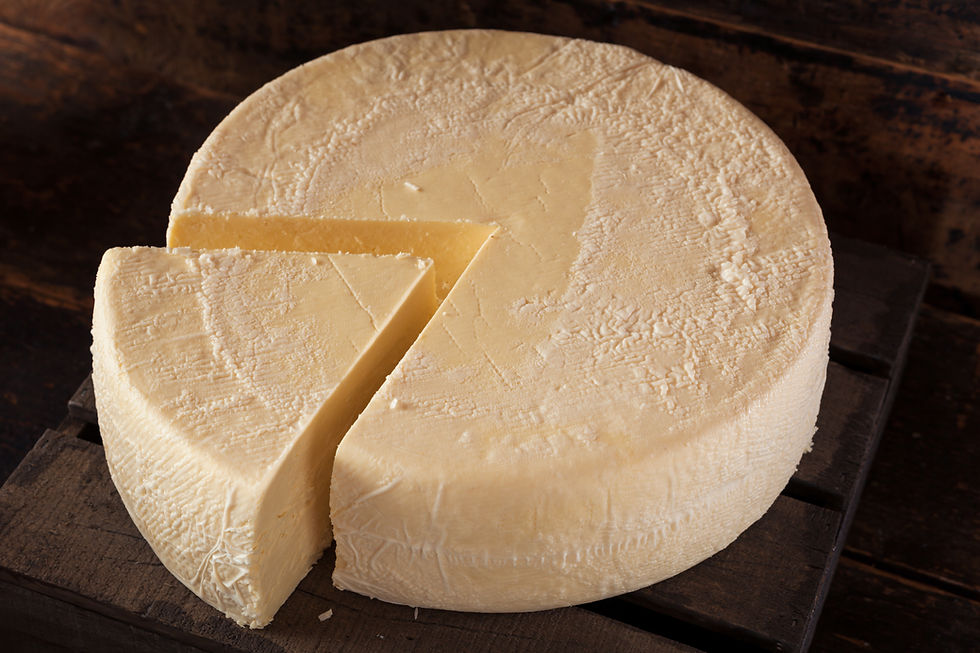History and Charm of Swiss Cheese
- Akanksha Singh

- Jul 8, 2024
- 4 min read
Swiss Cheese is celebrated for its unique flavour and characteristic holes. Its roots can be traced back to the picturesque Emmental region in Switzerland, where the cheese-making tradition has been honed for centuries. This article delves into the fascinating history of Swiss cheese, its production methods, scientific discoveries, and the diverse types of Swiss cheese that tantalize our taste buds.

Historical Roots

The story of the Swiss cheese began in the Emmental region of West Central Switzerland. This area, renowned for its rolling pastures, has been ideal for dairy farming for thousands of years. Historical records suggest that Swiss cheese production in Emmental dates back to the early 1300s. However, it wasn’t until the 1800s that the first cheese dairies were established, marking the beginning of large-scale cheese production in the region.
The Emmental region’s rich pastures provide the perfect environment for dairy cattle, whose milk is used to produce cheese. Over time, cheese from Emmental gained popularity due to its distinctive taste and appearance. The unique holes, or 'eyes' in Swiss cheese became its trademark due to the cheese-making process involving a specific bacteria.
The Cheese-Making Process
Swiss cheese, called Emmental in Europe, undergoes a meticulous process. The characteristic holes are created by the addition of gram-positive bacteria to the starter culture. These bacteria produce carbon dioxide as well as lactic acid during the fermentation process. The gas forms bubbles, which eventually create the holes in cheese. This process also contributes to the cheese’s sweet and nutty flavour.
Traditionally, Emmental cheese was made in large copper kettles, where milk was heated and curled. The curds were then cut, stirred, and heated again to release whey. After draining the whey, the curds were transferred into moulds and left to mature. The ageing process, which could last several months, allowed the bacteria to develop the characteristic holes and flavours.
The Mystery of the Holes

For many years, it was believed that bacteria alone was responsible for holes in Swiss cheese. However, a significant discovery in 2015 revealed that microscopic hay particles played a crucial role in the formation of these holes. Scientists from Agroscope, a Swiss government agricultural institute, found that tiny flecks of hay, which fell into the milk at the time of milking served as nuclei for gas bubbles. As the cheese aged, the bubbles expanded and created distinctive holes.
This discovery explained why holes in Swiss cheese had been getting smaller over the years. Modern hygienic milking methods reduced the presence of hay particles, which inadvertently led to a decrease in the size and number of holes. This finding underscored the intricate relationship between traditional cheese-making practices and the unique characteristics of Swiss cheese.
Types of Swiss Cheese
Switzerland boasts a rich variety of cheese, each with its unique flavour and texture. Here are some of the most notable varieties:
Emmental
Emmental has a quintessential semi-hard texture with butter to nutty flavour and large holes. It is produced in the Emmental region, where it gets its name. The cheese is aged for several months, allowing it to develop its characteristic taste and texture.
Gruyère
Gruyère is s a rich, creamy and slightly salty cheese that originated in the Gruyère region in the 12th century. This cheese was initially created as a survival staple for cow herders. It pairs well with a variety of foods like ham, salami, and nuts. It is a popular choice for fondues and gratins.
Sbrinz
It is one of the oldest European cheeses, known for its hard texture and aromatic flavour. It can be eaten in small pieces or grated, making it a versatile addition to various dishes. This cheese is often used as a substitute for Parmesan cheese in Swiss cuisine.
Raclette du Valais
A full-fat and semi-hard cheese, it is produced exclusively in the Canton of Valais. It has a distinctive aroma and flavour that can vary depending on the cows’ diet. This variety of cheese is traditionally melted and served with potatoes, pickles, and onions making it a popular dish in Swiss households.
Appenzeller
Appenzeller is a straw-coloured cheese with a spicy flavour that has been produced for over 700 years. This cheese is known for its herbal brine and rub that contributes to its unique taste. It is excellent for melting and grilling and pairs well with fruits and nuts.
Vacherin Fribourgeois
This is a semi-soft cheese known for its strong aroma and excellent melting properties. It is a key ingredient in fondues and pairs well with wines such as Rioja, Piedmont, and Riesling. The cheese’s name is derived from the Latin word vaccarinus meaning little cowherd.
Conclusion
Swiss cheese has a rich history and its diverse varieties remain a beloved staple worldwide. From its origins in the Emmental region to the scientific discoveries that unveiled the mysteries of holes, Swiss cheese continues to captivate cheese enthusiasts. Whether enjoyed in a fondue, melted over a dish, or savoured on its own, Swiss cheese offers a delightful experience that reflects the rich culinary heritage of Switzerland.
Akanksha Singh

Akanksha Awadhesh Singh was born and brought up in India and is currently pursuing Master of Food Science and Nutrition, at the University of Adelaide in Australia. Currently, she works as a health writer in Health Today in New York, where she mostly writes blogs based on food, health and wellness. She is also a poet and has published a poetry journal entitled Ehsaas. She also maintains a blog page on Medium.com. In her spare time, she loves to read books and listen to some good music. Even though she never lived in Basel, she is highly fascinated by Basel food and culture.
Website: https://medium.com/@akankshaasingh1998.




Comments